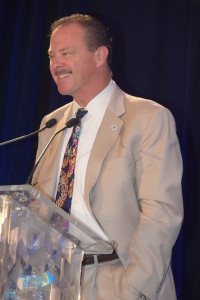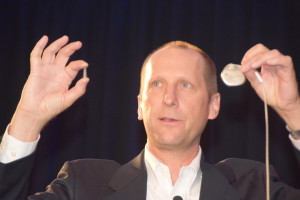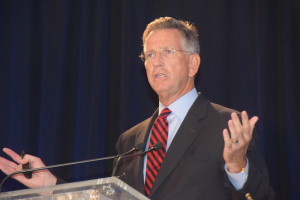When it comes to innovation in the biosciences, Arizona’s got it going on!
AZBio Expo 2014 had “aha moments” at every turn. With over 250 entrepreneurs, innovators, business leaders, legislators, scientists and researchers in attendance, the energy was sizzling and the outlook endless. Here are just a few of the event highlights, appropriately, A to Z:
A – Access to Capital is the key.
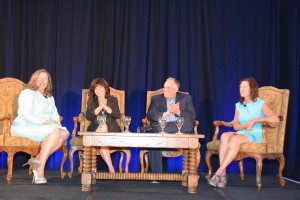
AZBio CEO Joan Koerber-Walker, BioAccel’s MaryAnn Guerra, Integrus Capital’s Paul Jackson, and Kelly Slone from the National Venture Capital Association discuss access to capital and the path to funding. (Photo by Mark Goldstein)
No money. No honey. Capital fuels innovation and commercialization. In the first panel discussion of the day – Funding Paths for Innovators – AZBio chief Joan Koerber-Walker engaged Mary Ann Guerra (BioAccel), Paul Jackson (Integrus Capital/Worthworm) and Kelly Slone (National Venture Capital Association) in a no-holds barred discussion. “The entire ecosystem has changed,” according to Slone. “After the tech bubble burst, available venture dollars have been virtually cut in half.” Guerra explains that only one in 100 will get angel funding – and then only one in 100 will get venture funding. We need to think of new ways to help our startup entrepreneurs get funding.” Jackson urges innovators to think like investors and offers one solution with his online valuation process, Worthworm.
B – Bridging the Gap with the 21st Century Cures Initiative.
“No industry has to face the challenges we face to bring a product to market,” says Koerber-Walker. “We have new hope in the 21st Century Cures Initiative. Google it. Watch the videos, See what they are doing. There is exciting stuff happening and some of it is happening in Arizona.”
Scottsdale’s Mayor Jim Lane shares his pride and plans for the largest concentration of bioscience businesses in the U.S., the Cure Corridor, bounded on one side by the Scottsdale Airpark on the West, and the Fountain Hills Mayo facility on the East, “a major driver of our economy, with $2½ billion in direct economic impact and $3.5 billion in indirect impact.” According to Lee, “Health and wellness are a part of Scottsdale’s identity. We should never stop asking how we can find new answers alleviate pain, restore health and improve the quality of life.”
D – Discovery. Development. Delivery.
Valley Fever Solutions CEO David Larwood shared his company’s formula for achieving success in development and funding – The Five R’s:
- Right drug.
- Right patient.
- Right safety.
- Right time. (How long before we can sell it?)
- Right reimbursent.
E – Epigenetics and Personalized Medicine
Start-up company INanoBio founder and CEO Bharath Takupalli, explained that the genome sequencing market is expected to grow to $10 billion by 2020. With a unique capability to combine nanotechnology and biomedicine, his company is in the lead for building new solutions now. “We aim to develop a $100 ultrafast nanopore-based desktop sequencer – a point-of-care diagnostic” that will help change the face of healthcare, he explains.
F – Funding needs to be the focus for the future.
According to a Flinn Foundation/Batelle report, “Arizona has many bioscience strengths and opportunities, but a substantial increase in private and public investment will be needed over the next decade to realize the [Flinn Foundation’s] Roadmap’s goals.” Last year, Arizona bioscience sector attracted $37 million in venture capital investment, up from $23 million from 2012, but that is only a fraction of the $9.8 billion invested nationally.
The goal is to increase the annual investment up to $40 million for seed capital in emerging companies and up to $125 million in venture capital.
G – Genomic advances hold high hopes for positively disruption.
Explaining that healthcare premiums are growing at three times the rate of inflation and wages, Frederic Zenhausern, Ph.D., MBA, president of Whitespace Enterprise, says “The new era of precision healthcare (also called personalized healthcare) will provide more accessibility, transparency and health information to improve – dramatically – quality and lower cost over time.” His start-up company, based in Fountain Hills, develops methods for automating and miniaturizing the workflow processing of biological specimens.
H – Henry Ford.
“I am looking for a lot of men who have an infinite capacity to not know what can’t be done,” said Henry Ford. So does Robert Penny, M.D., Ph.D., co-founder and CEO of the International Genomics Consortium and founder and CEO of Paradigm. “Phoenix has become the Grand Central Station for all the aggregating and analyzing cancer tissues. We have 10,000 tumors – and the information is publicly available. This will accelerate cancer discovery at a rate faster than ever,” he says. “This is a tidal wave that Arizona has led. Everyone in this room should be grabbing a surfboard and figuring out how to ride it.”
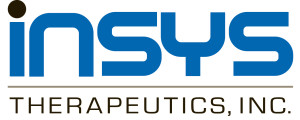 I – IPO: The nation’s top IPO of 2013 is right here in River City. (Well, Chandler, actually.)
I – IPO: The nation’s top IPO of 2013 is right here in River City. (Well, Chandler, actually.)
With 380 percent growth in shareholder value, Insys Therapeutics, a commercial-stage specialty pharmaceutical company, ended the year with a market cap of $800 million. Darryl Baker, the chief financial officer, explained how the company, founded in 2002 by Dr. John Kapoor, was determined to discover better ways to deliver existing medications to patients. A sublingual fentanyl spray technology delivers treatments to opioid-tolerant cancer patients and holds real possibilities for better helping patients with acute pain, major burns and pediatric issues. In the R&D pipeline now is the development of a pharmaceutical cannabinoid, aimed at easing epilepsy, peripheral neuropathy and cocaine addiction.
J – Jobs: 107,000 bioscience jobs – good-paying and growing.
Arizona has nearly 107,000 bioscience jobs, based on 2012 industry data, and the sector contributes an estimated $36 billion in revenue to the state’s economy, according to a study by the Ohio-based Battelle Technology Partnership Practice. Hospitals account for 83,000 of those jobs and $22 billion of the revenue. Arizona’s average annual wage in the bioscience sector is $62,775, 39 percent higher than the private-sector average, the report said. Not counting hospital jobs, the average wage for bioscience jobs jumps to $85,571. (2013 data).
K – Kalos Therapeutics is building a promising platform for future drug discovery.
Start-up innovator Michael Kozlowski, OD, Ph.D., chief science officer of Kalos Therapeutics, explains that their focus on transforming the atrial natriuretic family of peptides engages a natural biochemical mechanism. This approach holds promise for people with pancreatic cancer because it results in a more complete response, reduced side effects and improved safety and a longer period of effectiveness.
L – Let’s leverage every resource, strength, collaboration and person we’ve got!
Arizona’s bioscience industry is aiming to increase research revenue for institutions statewide by 69 percent over the next decade to $782 million and attract additional anchors for the sector.
M – Medtronic models aggressive, needs-focused growth.
Keynote speaker Ron Wilson, vice president and general manager of the Medtronic Tempe campus made it clear that passion for people runs through his veins. Locating a small manufacturing facility here in 1973, the company’s facility today covers 30 acres, has 900 employees and generates $17 billion in revenues. How do they do it? We follow our founder’s vision still: We understand what the unmet needs are and we apply our knowledge for the good of people all over the world.”
N – Next Level
“Arizona has made unprecedented progress over the last decade in developing the talent, building research infrastructure, and growing its base. Taking it to the Next Level will require new collaborative partnerships, forward looking leaders, and aggressive investments from both the public and private private sectors to take our place in the top tiers globally”shared Koerber-Walker. “Now is our time. Let’s get it done!”
O – Orphans no more.
Valley fever, considered an orphan disease, hits about 150,000 people a year – 60 percent live in central Arizona. Current treatments have major shortcomings, with about 60 percent of those treated being unresponsive. The result is 2,000 serious cases and 150 deaths a year. It affects pets in nearly equal proportion. David Larwood, CEO of Valley Fever Solutions, has some answers. His company is developing Nikkomycin Z (NikZ) as a dramatically superior potential cure for Valley Fever. To help raise awareness and prevention, the Arizona Board of Regents created Valley Fever Corridor project, a public health program led by University of Arizona College of Medicine’s John Galgiani, MD, who is also the chief medical officer for Valley Solutions.
P – Policymakers are on board.
Gov. Jan Brewer’s time is coming to a close and it’s time to decide which candidate can bring their best to bioscience. Recognizing that the Arizona bioscience sector is growing at four times the rate of the national average, candidates Christine Jones, Doug Ducey, Fred Duval, Ken Bennett and Scott Smith shared their ideas on how to ramp up funding and revenues in 90-second videos. Koerber-Walker says, “The most important thing we can do this summer is vote in the primaries.”
Click here to see what each candidate had to say on AZBio.tv.
Q – Cues: Here are a few Q’s for success.
Some lessons learned, courtesy of Robert Penny:
Make sure you have:
- Complementary skills and expertise
- Trust
- Interpersonal chemistry (It’s better to navigate bumps in the road with people you trust than people you don’t!)
Pick the right projects:
- Big enough to be worthy of your efforts
- Complex enough to need partnerships
- Audacious enough to move the field
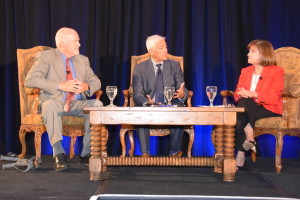
David Larwood of Valley Fever Solutions, Gaspar Laca of GSK, and Debbie McCune Davis of TAPI (Photo by Mark Goldstein)
R – Remembering Polio: Can Looking Back Catapult Us Forward?
How did we cure the world of polio? What did it take to conquer the most feared disease of the 20th Century? What threatens our world today and how can we continue to keep people healthy with the right vaccines, for the right person at the right time? Gaspar Laca, state government affairs director at GlaxoSmithKime, engaged David Larwood, CEO and president of Valley Fever Solutions (and a person who has been directly affected by polio) and Rep. Debbie McCune Davis, executive director of The Arizona Partnership for Immunization, in a rousing discussion of what’s happening in Arizona today, the mounting threats of the ”vaccine exemptors,” and what we need to do now. (See Vaccines.)
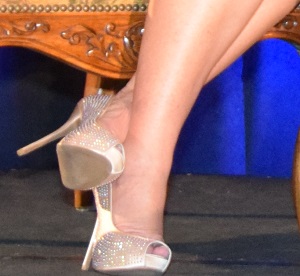 S – Shoes. Did you see those shoes?
S – Shoes. Did you see those shoes?
“Give a girl the right shoes and she can conquer the world!” Enough said.
T – Tucson’s Critical Path Institute creates new tools.
A jewel in the bioscience crown – and located right here in Arizona! The Critical Path Institute (C-Path) is a breakthrough organization, creating a new movement: “consensus science.” Keynoter Martha Brumfield. Ph.D, president and CEO, shared what can be achieved when people come together with the belief that a “rising tide floats all boats.” Working to improve the unacceptable 95 percent failure rate in the testing of new drug therapies, C-Path is improving medical product development efficiencies by identifying pathways that integrate new scientific advances into the regulatory review process. Check out their Alzheimer’s clinical trial simulation tool.
U – United we stand.
Mayors Jim Lane (City of Scottsdale) and John Lewis (Town of Gilbert) will join Koerber-Walker and an Arizona bioscience-business contingent next week at the 2014 BIO International Convention in San Diego (June 23-26), the world’s largest biotechnology gathering. They will surely scoop up new ideas, new connections – and with any luck, new investment!
V – Vaccines: Get ‘em! Talk about ‘em. Challenge the myths. Explain the realities.
Polio. Measles. And whooping cough today. Without proper vaccinations, whooping cough (pertussis) could be the polio of our time. “As science-minded people, the best thing you can do is activate conversations about the importance of vaccinations. Here’s some help: Why immunize?
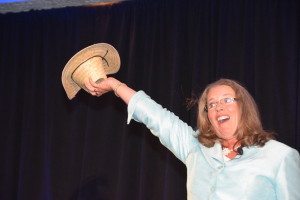 W – White Hat event brings in national investors. (Apply by July 15th.)
W – White Hat event brings in national investors. (Apply by July 15th.)
“AZBio’s White Hat Investor’s Conference is the first ever life science specific investor conference to be held in Arizona,” says Koerber-Walker. “Kelly Slone [of the National Venture Capital Association] has been an amazing partner to bring this together along with the state bioscience association leaders from across the Rocky Mountain Southwest Region. Investors and investment firms from across the country will be here, so get involved. Even if you feel like you are not ready yet, take the leap and apply to present. “
X – “X” marks the spot for our next big gathering. Wear your White Hat!
The West was won by innovators, investors, and prospectors who understood the value of discovery and accepted the challenge of investing in new frontiers. Meet a new generation of biotech and healthcare pioneers at White Hat Investors 2014, the first annual biotech and healthcare investor conference that showcases the best of the Rocky Mountain & Southwest Region.
Bioindustry Associations from across the Rocky Mountain and Southwest Region are coming together to present an opportunity for Angels, Venture Capitalists and Strategic Investors to connect with the best biotech and healthcare investment opportunities from across the Rocky Mountain & Southwest states at White Hat Investors 2014 in Phoenix, Arizona on September 17 & 18, 2014.
Presenting Companies will be selected from the region’s emerging innovator leaders in the fields of:
- Diagnostics
- Therapeutics
- Medical Devices
- Health IT
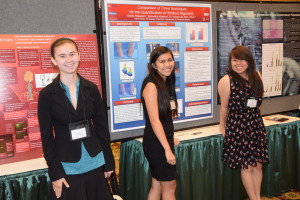 Y – Young Talent is being cultivated.
Y – Young Talent is being cultivated.
We got it! With nearly 50 abstracts accepted and student presenters presenting at the Expo, Koerber-Walker got it right when she said, “These young people are going to be working on things that we can’t even begin to imagine!” Arizona’s tremendous mentoring people and organizations are sharing knowledge, support and inspiration. For example University of Arizona student Keeley Brown is destined to help the world crack the code on genetically modified foods and farming. (Her presentation was the “Epigenetic Effects of Transgenic Manipulation in Glycine Max (Soybeans).
Zzzzzzzzz – No one fell asleep at this conference!
Catherine Leyen, founder and CEO of start-up RadiUp, says she comes to AZBio to stay abreast of the action, connect with like-minded people and soak up inspiration. Her verdict of AZBIO Expo 2014? Mission accomplished!
Editor’s Note: With information flying fast and furious, we’ve done our best to deliver good information in a timely way. To get the full story with detail and precision, we encourage you to visit websites; better yet, make a personal connection where you see opportunities for collaboration of learning.
Learn More – Check out the Arizona Bioscience Industry Fact Sheet
Dianne Price is a local freelance journalist/blogger and communications strategist who specializes in sharing information about health, medicine and the sciences. She is a regular contributor to Brain World, a national magazine that explores cutting-edge science and how its findings can affect human health, culture, education, global issues and more.

